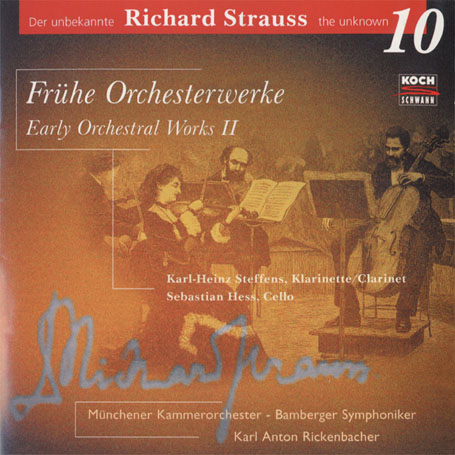R Strauss - Early Orchestral Works II
A collection of well-performed early works which, though they’re unlikely to interest most listeners, will at least please Strauss fans
View record and artist detailsRecord and Artist Details
Composer or Director: Richard Strauss
Label: Koch Schwann
Magazine Review Date: 9/2000
Media Format: CD or Download
Media Runtime: 65
Mastering:
DDD
Catalogue Number: 365402

Tracks:
| Composition | Artist Credit |
|---|---|
| Festmarsch |
Richard Strauss, Composer
Bamberg Symphony Orchestra Karl Anton Rickenbacher, Conductor Richard Strauss, Composer |
| Romanze for Clarinet and Orchestra |
Richard Strauss, Composer
Bamberg Symphony Orchestra Karl Anton Rickenbacher, Conductor Karlheinz Steffens, Clarinet Richard Strauss, Composer |
| Romanze |
Richard Strauss, Composer
Bamberg Symphony Orchestra Karl Anton Rickenbacher, Conductor Richard Strauss, Composer Sebastian Hess, Cello |
| Concert Overture |
Richard Strauss, Composer
Bamberg Symphony Orchestra Karl Anton Rickenbacher, Conductor Richard Strauss, Composer |
| Romeo und Juliet, Movement: Tanzlied zur Moresca |
Richard Strauss, Composer
Bodil Arnesen, Soprano Christa Mayer, Contralto (Female alto) Jennifer Crohns, Mezzo soprano Karl Anton Rickenbacher, Conductor Michael Suttner, Tenor Munich Chamber Orchestra Richard Strauss, Composer Via Nova Choir |
| Romeo und Juliet, Movement: Trällerlied |
Richard Strauss, Composer
Bodil Arnesen, Soprano Christa Mayer, Contralto (Female alto) Jennifer Crohns, Mezzo soprano Karl Anton Rickenbacher, Conductor Michael Suttner, Tenor Munich Chamber Orchestra Richard Strauss, Composer Via Nova Choir |
| Romeo und Juliet, Movement: Vor dem Hochzeitsbette |
Richard Strauss, Composer
Bodil Arnesen, Soprano Christa Mayer, Contralto (Female alto) Jennifer Crohns, Mezzo soprano Karl Anton Rickenbacher, Conductor Michael Suttner, Tenor Munich Chamber Orchestra Richard Strauss, Composer Via Nova Choir |
| Romeo und Juliet, Movement: Trauermusik |
Richard Strauss, Composer
Bodil Arnesen, Soprano Christa Mayer, Contralto (Female alto) Jennifer Crohns, Mezzo soprano Karl Anton Rickenbacher, Conductor Michael Suttner, Tenor Munich Chamber Orchestra Richard Strauss, Composer Via Nova Choir |
| Vier Lebende Bilder |
Richard Strauss, Composer
Bamberg Symphony Orchestra Karl Anton Rickenbacher, Conductor Richard Strauss, Composer |
Author: David Gutman
In this tenth volume of Koch Schwann’s ‘Unknown Strauss’ edition, Karl Anton Rickenbacher again secures some excellent playing, and the recordings are sensitively managed. There remains, however, the problem of the music itself and, while ardent Strauss buffs will be delighted, there is less to interest the uncommitted.
Strauss’s Festmarsch, Op 1 (1876), though published by Breitkopf (at his uncle’s expense), betrays no hint of the genius to come. Strauss was not (or not consistently) a Mendelssohn or a Korngold in this respect. The work of a well-schooled 12-year-old, the piece’s most characteristic quality may be its nonchalant theft of a key melodic twist from the finale of Beethoven’s Seventh. Of the two Romances, the one for cello (1883) has the greater melodic individuality, though this is still fairly anodyne stuff. Michael Kennedy’sRichard Strauss: Man, Musician, Enigma (CUP: 1999) tells us that it enjoyed a brief period of popularity before lapsing into the obscurity from which it was rescued in the 1980s.
The cellist here, impassioned but a bit buzzy as miked, is up against competition from starrier names, including Wallfisch, Schiff and Maisky. The Concert Overture in C minor, written at much the same time, has already had one airing in this series (Koch Schwann, 10/97); a close relative of Beethoven’s Coriolan and equally indebted to Mendelssohn and Schumann, it has stiffer joints. Norman Del Mar described the incidental music to Romeo und Juliet (1887) as ‘both inconsiderable and uncharacteristic’, with none of the distinction that marks Strauss’s early song-writing. The Lebende Bilder (1892) are more mature in terms of style, and the composer thought well enough of them to recycle some of the material. Even so, one might wonder why he bothered, hard at work as he was on the opera Guntram.
Those who must have every bar from the master’s pen will no doubt be adding this issue to their collection.'
Strauss’s Festmarsch, Op 1 (1876), though published by Breitkopf (at his uncle’s expense), betrays no hint of the genius to come. Strauss was not (or not consistently) a Mendelssohn or a Korngold in this respect. The work of a well-schooled 12-year-old, the piece’s most characteristic quality may be its nonchalant theft of a key melodic twist from the finale of Beethoven’s Seventh. Of the two Romances, the one for cello (1883) has the greater melodic individuality, though this is still fairly anodyne stuff. Michael Kennedy’s
The cellist here, impassioned but a bit buzzy as miked, is up against competition from starrier names, including Wallfisch, Schiff and Maisky. The Concert Overture in C minor, written at much the same time, has already had one airing in this series (Koch Schwann, 10/97); a close relative of Beethoven’s Coriolan and equally indebted to Mendelssohn and Schumann, it has stiffer joints. Norman Del Mar described the incidental music to Romeo und Juliet (1887) as ‘both inconsiderable and uncharacteristic’, with none of the distinction that marks Strauss’s early song-writing. The Lebende Bilder (1892) are more mature in terms of style, and the composer thought well enough of them to recycle some of the material. Even so, one might wonder why he bothered, hard at work as he was on the opera Guntram.
Those who must have every bar from the master’s pen will no doubt be adding this issue to their collection.'
Discover the world's largest classical music catalogue with Presto Music.

Gramophone Digital Club
- Digital Edition
- Digital Archive
- Reviews Database
- Full website access
From £8.75 / month
Subscribe
Gramophone Full Club
- Print Edition
- Digital Edition
- Digital Archive
- Reviews Database
- Full website access
From £11.00 / month
Subscribe
If you are a library, university or other organisation that would be interested in an institutional subscription to Gramophone please click here for further information.




